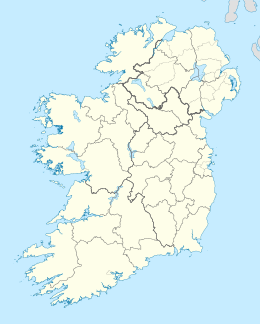
Swords, the county town of Fingal, is a large suburban town on the east coast of Ireland, situated ten kilometres north of Dublin city centre. The town was reputedly founded c. AD 560. Located on the Ward River, Swords features Swords Castle, a restored medieval castle, a holy well from which it takes its name, a round tower and a Norman tower. Facilities in the area include the Pavilions shopping centre, one of the largest in the Dublin region, a range of civic offices, some light industries, the main storage facility and archive of the National Museum of Ireland and several parks. Dublin Airport is located nearby.

Duke of Leinster is a title in the Peerage of Ireland and the premier dukedom in that peerage. The subsidiary titles of the Duke of Leinster are: Marquess of Kildare (1761), Earl of Kildare (1316), Earl of Offaly (1761), Viscount Leinster, of Taplow in the County of Buckingham (1747), Baron of Offaly, Baron Offaly (1620) and Baron Kildare, of Kildare in the County of Kildare (1870). The viscounty of Leinster is in the Peerage of Great Britain, the barony of Kildare in the Peerage of the United Kingdom, and all other titles in the Peerage of Ireland. The courtesy title of the eldest son and heir of the Duke of Leinster is Marquess of Kildare. The Duke of Leinster is the head of the House of Kildare.
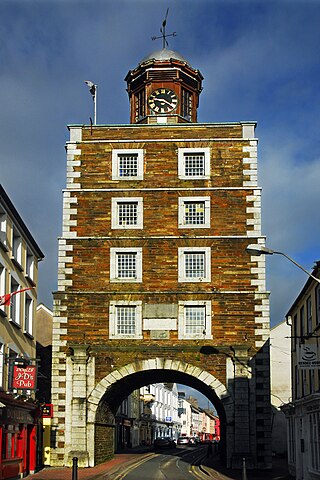
Youghal is a seaside resort town in County Cork, Ireland. Located on the estuary of the River Blackwater, the town is a former military and economic centre. Located on the edge of a steep riverbank, the town has a long and narrow layout. As of the 2022 census, the population was 8,564.

The Knight of Glin, also known as the Black Knight or Knight of the Valley, was a hereditary title held by the FitzGerald and FitzMaurice families of County Limerick, Ireland, since the early 14th century. The family was a branch of the FitzMaurice/FitzGerald Dynasty commonly known as the Geraldines and related to the now extinct Earls of Desmond who were granted extensive lands in County Limerick by the Crown. The title was named after the village of Glin, near the Knight's lands. The Knight of Glin was properly addressed as "Knight".
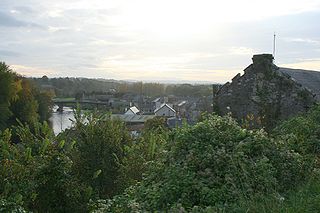
Thomastown, historically known as Grennan, is a town in County Kilkenny in the province of Leinster in the south-east of Ireland. It is a market town along a stretch of the River Nore which is known for its salmon and trout, with a number of historical landmarks in the vicinity. Visitor attractions include Jerpoint Abbey, Kilfane Glen gardens, and Mount Juliet Golf Course.

Castlemartyr is a large village in County Cork, Ireland. It is around 30 kilometres (19 mi) east of Cork city, 10 km (6 mi) east of Midleton, 16 km (10 mi) west of Youghal and 6 km (4 mi) from the coast. Approximately 1,600 people live in the village and its hinterland. It is situated on the N25 national primary road and the R632 regional road.

Carton House is a country house and surrounding demesne that was the ancestral seat of the Earls of Kildare and Dukes of Leinster for over 700 years. Located 23 km west of Dublin, in Maynooth, County Kildare, the Carton Demesne is a 1,100 acres estate, from an original estate of 70,000 acres. For two hundred years, the Carton Demesne was the finest example in Ireland of a Georgian-created parkland landscape. In the 2000s, much of the demesne was redeveloped into two golf courses and the house into a hotel complex.

In modern Newfoundland, many Newfoundlanders are of Irish descent. According to the Statistics Canada 2016 census, 20.7% of Newfoundlanders claim Irish ancestry. However, this figure greatly under-represents the true number of Newfoundlanders of Irish ancestry, as 53.9% claimed "Canadian" as their ethnic origin in the same census. The majority of these respondents were of Irish, English, and Scottish origins, but no longer self-identify with their ethnic ancestral origins due to having lived in Canada for many generations. Even so, the family names, the features and colouring, the predominance of Catholics in some areas, the prevalence of Irish music, and even the accents of the people in these areas, are so reminiscent of rural Ireland that Irish author Tim Pat Coogan has described Newfoundland as "the most Irish place in the world outside of Ireland."

Gerald FitzGerald, 14th Earl of Desmond, also counted as 15th or 16th, owned large part of the Irish province of Munster. In 1565 he fought the private Battle of Affane against his neighbours, the Butlers. After this, he was for some time detained in the Tower of London. Though the First Desmond Rebellion took place in his absence, he led the Second Desmond Rebellion from 1579 to his death and was therefore called the Rebel Earl. He was attainted in 1582 and went into hiding but was hunted down and killed.

The history of Ireland from 1169–1536 covers the period from the arrival of the Cambro-Normans to the reign of Henry II of England, who made himself King of Ireland. After the Norman invasion of 1169–1171, Ireland was under an alternating level of control from Norman lords and the King of England. Previously, Ireland had seen intermittent warfare between provincial kingdoms over the position of High King. This situation was transformed by intervention in these conflicts by Norman mercenaries and later the English crown. After their successful conquest of England, the Normans turned their attention to Ireland. Ireland was made a lordship of the King of England and much of its land was seized by Norman barons. With time, Hiberno-Norman rule shrank to a territory known as the Pale, stretching from Dublin to Dundalk. The Hiberno-Norman lords elsewhere in the country became Gaelicised and integrated in Gaelic society.

Cappoquin, also sometimes spelt Cappaquin, is a town in western County Waterford, Ireland. It is on the Blackwater river at the junction of the N72 national secondary road and the R669 regional road. It is positioned on a sharp 90-degree bend in the river and lies at the foot of the Knockmealdown Mountains. The town is a few miles from Mount Melleray and Lismore, County Waterford.
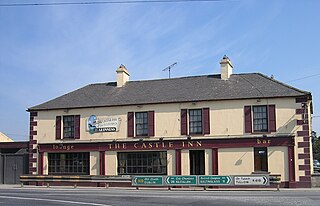
Castledermot is an inland town in the south-east of Ireland in County Kildare, about 75 km (47 mi) from Dublin, and 10 km (6.2 mi) from the town of Carlow. The N9 road from Dublin to Waterford previously passed through the village but upon completion of a motorway bypass in 2010, it was re-designated the R448.

Ravensworth is a village and civil parish in the Holmedale valley, within the Richmondshire district of North Yorkshire, England. It is approximately 4.5 miles (7.2 km) north-west of Richmond and 10 miles (16 km) from Darlington. The parish has a population of 255, according to the 2011 census.
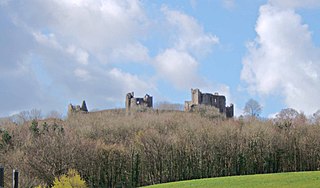
Llansteffan Castle is a privately owned castle in Llansteffan, Carmarthenshire, Wales, overlooking the River Tywi estuary in Carmarthen Bay.

Mahoonagh or Castlemahon is a village and civil parish in County Limerick, Ireland. The village lies four kilometres south east of the town of Newcastle West.

Kilmeadan or Kilmeaden is a village in County Waterford, Ireland. It is 10 km (6 mi) west of the centre of Waterford city on the R680 road.

Croom or Crom Castle, also called the Castle of Crom, is a historic castle in the town of Croom, County Limerick, that is notable for its occupation as one of the principal residences of the Kildare branch of the FitzGerald dynasty. Their ancient war cry and motto "Crom a Boo", or in Irish "Crom Abú" or "Crom forever", comes from the strategic fortress. Before the FitzGeralds it was the site of an earlier fortress of the O'Donovans.
Castle Conway is a former castle and stately home in the town of Killorglin, County Kerry, Ireland. Today only the ruins of one wall remain.
Warner Leisure Hotels is a hospitality company owning 14 country and coastal properties around the UK in North Wales, Somerset, Herefordshire, Berkshire, North Yorkshire, Nottinghamshire, Isle of Wight, Suffolk, Hampshire and Warwickshire. Founded in 1932 as Warner Holiday Camps, later known as Warner Holidays being adult only since 1994. In the 1990s Warner's started developing country house hotels and changing their existing 'camps' into coastal resorts and hotels.

Johnstown Castle is a Gothic Revival castle located in County Wexford, Ireland.

